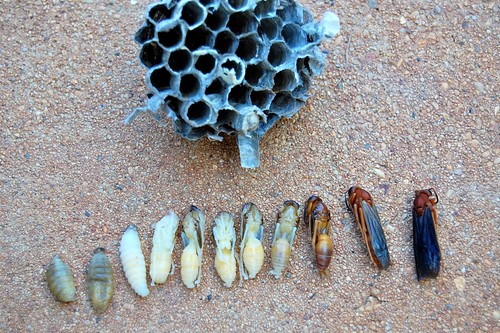
A few weeks ago, while Travis and I were procrastinating major projects, we removed a red wasp nest from inside our otherwise vacant wren house. We haven't been successful at getting wrens to move in and we felt that the wasps were worsening our prospects.

Our philosophy about bugs is "live and let live." But if that isn't possible, we try to use a less toxic means of removal. In this case, that meant that I slipped the house into a plastic bag and Travis flooded it with water. The next day, Trav inspected the nest chambers and removed all of the developing larvae. It sounds gross, but it was really fascinating to see the wasps in different stages of development.
A few of the mason bee houses that I've seen in magazines.
That sent the the two of us on a detour researching mason bees and watching videos about how to build a bee house. We learned that mason bees don't sting unless you handle them roughly, they don't mind you observing them up close, and since they are harrier than honey bees and don't have pouches to carry pollen, they are sloppier (and thus better) pollinators. Each female bee prepares her own nest in a preexisting hollow, narrow hole. She leaves enough nector and pollen to feed her devloping babies but doesn't stick around to nurture a colony.
At some point during our research, I suggested we could probably make our own mason bee house out of pants hangers and PVC pipe. My dad always has PVC and way too many dry cleaner hangers so I left him a voicemail describing my idea.
 |

I spray painted it and we mounted it under a southeast facing eave of the house. We read that the rising sun stimulates the bees' activity. In South Texas, mason bees start working on their nests in February and March, and they are dormant during the fall and winter so we aren't expecting any tenents in our new apartment until next year. I hope we are more successful than we've been thus far with the wrens.


That Mason Bee house is pretty snazzy! BTW: have heard that if you take plain ivory soap and rub it on the underside of the wren house roof (inside and out), it will prevent wasps from nesting there.
ReplyDeleteThanks RB. I'll have to try that.
ReplyDeleteThere are definitely benefits of living close to your parents! What did he use to make the holes (tubes) with?
ReplyDeleteHGG, I love my dad. The tubes are the cardboard parts of the slacks hangers that dry cleaners use. Slipped the tube off of the wire and cut the tubes in half.
ReplyDeleteBe sure you click the YouTube link. You'll laugh. And learn something too.
ReplyDeleteThat's really cool! I really admire all that you do to both cultivate and preserve nature! :)
ReplyDeleteI'll be curious how that works out for you. I've had a bee house for a year and a half, and found out last spring that 70% of the bees here want bare ground to dig holes in (and I have mostly wood chip cover. Still, even the other 30% haven't really made themselves very obvious, and I'm starting to think the house is in too hot a spot. Your location looks like a very good choice.
ReplyDeleteFascinating post! Your dad is a genius! Feel free to link this post to my Creature Feature meme published today!
ReplyDeleteThanks for the invite Jim. I posted my link.
ReplyDeleteGreat house Abbey. Did you purchase the cardboard liner tubes, or make your own? We went to a Mason Bee class last spring, and learned a lot about these lovely bees, and felt it was important to encourage them on the farm. We installed our first Mason bee house too, and by early summer we had a few tubes all filled up, that hopefully will hatch next spring. I haven't had a chance to post about them yet, but we used a house very similar to the one you showed from High Country, and they seemed to like it. Good luck, I wish you lots of filled bee tubes next spring.
ReplyDeleteThanks Curbstone. I look forward to reading about your bees and learning from your experience. We didn't really buy or make the tube liners, we just repurposed the tubes from the slacks hangers that the dry cleaner provides when you pick up your clothes. That's what the tubes in the High Country house reminded me of so I thought we'd give it a try. I hope the bees like them.
ReplyDeleteCheck out this website devoted to Mason Bees. Thanks Crown Bees for letting me know about your site. It was one of the most helpful ones I've read. http://www.crownbees.com/educate-yourself/mason-bee-basics
ReplyDelete